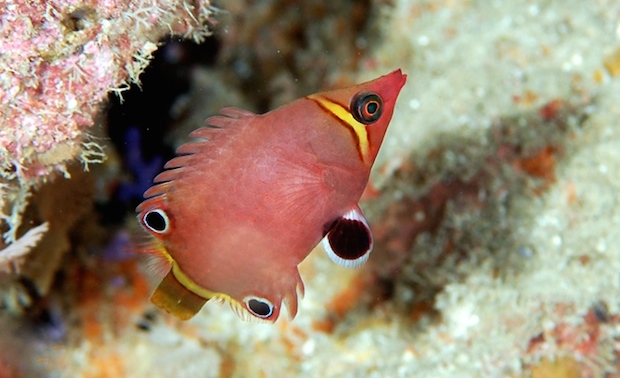Unlike Awesome Possum, Wetmorella does not can haz chezburgers, neither does it enjoy being an internet meme. Wetmorella is a small yet very interesting genus comprising of three Indo-Pacific species that lead very cloistered lives in dark caves and ledges. Their pointed snouts and large eyes have coined them the colloquial name of “possum wrasses“, which is actually pretty apt.
Wetmorella is represented by three species, namely W. nigropinnata, W. albofasciata and W. tanakai. The possum wrasses are not particularly colourful, having a base colour that can range from brick-red to burgundy. Apart from the minor differences in patterning, all are decorated with transverse bands and ocelli on the soft portions of their unpaired fins.

Depending on the species, juveniles of all three possess distinctive bands that either fade away with age, or thin out as they develop into their adult form. In W. nigropinnata, juveniles lose the two central bands as they grow into their adult coloration. It’s interesting to note that certain species of Labrids have juveniles that look very similar to Wetmorella. Juveniles of Cheilinus fasciatus and Epibulus insidator (below) for example are very often misidentified as possum wrasses.

No one really knows for sure the reason behind this mimesis, but it could be that predators avoid wasting time chasing after the cryptic and coy Wetmorella that are highly adept at manoeuvring around caves and reef catacombs. For this reason, the juveniles of Epibulus take advantage of this camouflage.
As mentioned before, Wetmorella are diffident fishes that live very apprehensively within the darkness of caves and the reef matrix. They are almost always found secretively in either coastal lagoons or deep reef slopes. None of the three species can be considered rare in the aquarium trade, but they cannot be considered common as well. Individuals do show up occasionally but not often in large quantities.

In the first species, Wetmorella nigropinnata is ferruginous with two transverse yellow bands that run on each end of the fish. The first one starts just behind the eye and the second band sits just shy of the caudal peduncle, at the end of the dorsal and anal fins. It is the only species in the genus that lacks the vertical banding in the middle portion of the body.
W. nigropinnata is widespread in the Indo-West Pacific, and can be found in Indonesia, Guam and all the way to the Maldives. It is the most frequently encountered species in the trade and has been spawned successfully in captivity.

In W. albofasciata, the ground colour is more brown with an olive slate. The banding on this species is more complicated than the rest, and is white throughout. The facial stripe is broken into two portions with each half converging at an angle toward the eye, passing through it horizontally and terminating at the mouth and chin respectively. The nape in-between the eyes can sometimes also be adorned with addition stripes.
It possesses a middle band which passes through the frontal part of the dorsal fin and ends just behind the ventrals, which can be red or black. The third band starts at the back of the dorsal ocelli and travels obliquely to the front of the anal ocelli in a very gentle “S” configuration. Occasionally, specimens may have an incomplete white band that appears just before the dorsal ocelli. This band is never complete and never passes a third of the body profile.
W. albofasciata is not as commonly seen compared to W. nigropinnata, but does makes it rounds every once in a while. This species, as mentioned above, serves as the model for juveniles of Epibulus insidiator.

W. tanakai is the final member of the genus, and in this beautiful species, more is known about it from the aquarium trade than in science. W. tanakai is only known from a few specimens, and very little information or photographs of it exists in the wild. However in the aquarium trade, this species is not rare and like W. albofasciata, does occasionally makes its rounds and appearances via Indonesian or Philippines imports.
This species can be differentiated from W. albofasciata by having the third stripe passing through the front of both the dorsal and anal ocelli. The anal fin ocelli is also longer and more tapered than the preceding two species. W. tanakai is a brighter red with an occasional splash of suffused yellow on the posterior region of the body.
All three species are hardy and share the same husbandry requirements. They are sheepish and require heavy rock work ideally with caves and overhangs to feel safe in. Wetmorella are slow moving, and swim in a hovering almost spaceship like manner. They are inquisitive yet reserved, and make for excellent aquarium candidates. Like Liopropoma, you probably will catch a glimpse of them every now and then, but with time they may actually venture out more.

And so we have at the opposite end of the wrasse spectrum, the lethargic moving but oh so charming Wetmorella. They certainly aren’t your adrenaline pumped Cirrhilabrus or Paracheilinus, but they do offer something that is uniquely possum and positively awesome. There’s no reason why you shouldn’t keep a pair of these in your tank!



